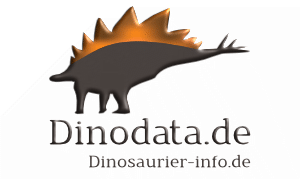FAMILIENLISTE / Hesperornithiformes

Fürbringer, 1888
Aves Pygostylia Ornithurae Hesperornithiformes
Die Familie der Hesperornithiformes ("westliche Vögel") waren bis zu 1,8 Meter große Wasservögel, die ähnlich wie die rezenten Pinguine nur Stummelflügel besaßen und mit ihren kräftigen Hinterbeinen schwammen. Mit ihren kurzen Beinen waren sie wahrscheinlich nicht in der Lage zu laufen. Die Hesperornithiformes besaßen einen bezahnten Schnabel und sind die bisher einzigen bekannten Vögel des Mesozoikum, die die Ozeane der nördlichen Hemisphere besiedelten. Wie viele andere mesozoischen Vögel wie zum Beispiel Ichthyornis hatten die Hesperornithiformes Zähne in ihrem Schnabel, die wahrscheinlich bei der Jagd halfen, ihre bevorzugte Beute, zumeist Fische, zu packen und zu halten. Obwohl einige der kleineren Arten fliegen konnten, hatten Baptornis und Hesperornis nur Ansätze kleiner Flügel. Die Schnäbel waren lang und trugen eine Reihe von einfachen scharfen Zähnen. Einige Forscher vermuten, dass die Hesperornithiformes aufgrund ihrer seitlich am Körper platzierten, gewinkelten Beine sich an Land auf dem Bauch rutschend vorwärts bewegten. Dieses Verhalten ist auch von rezenten Pinguinarten bekannt.
 Hesperornithiformes
Hesperornithiformes
-  Hesperornithidae
Hesperornithidae
-. Asiahesperornis
-. Baptornis
-. Canadaga
-. Enanliornis
-. Hesperornis (Typ)
-. Judinornis
-. Parahesperornis
-. Pasquiaornis

© Mineo Shiraishi
Weitere Informationen
A Middle Campanian, Nonmarine Occurrence of the Cretaceous Toothed Bird Hesperornis Marsh
Richard C. Fox , 1974 / Canadian Journal of Earth Sciences, 1974, 11(9): 1335-1338, https://doi.org/10.1139/e74-127
Comparative osteohistology of Hesperornis with reference to pygoscelid penguins: the effects of climate and behaviour on avian bone microstructure / Laura E. Wilson, Karen Chin, 2014 / R.Soc.opensci.1: 140245. dx.doi.org/10.1098/rsos.140245 /
/ Laura E. Wilson, Karen Chin, 2014 / R.Soc.opensci.1: 140245. dx.doi.org/10.1098/rsos.140245 / PDF
PDF
Cranial Kinesis in the Late Cretaceous Birds Hesperornis and Parahesperornis / Paul Bühler, Larry D. Martin, Lawrence M. Wittmer, 1988 / The Auk 105: 111-122
/ Paul Bühler, Larry D. Martin, Lawrence M. Wittmer, 1988 / The Auk 105: 111-122
Histological Evidence for the Systematic Position of Hesperornis (Odontornithes: Hesperornithiformes) / Peter Houde, 1987 / The Auk - Short Communications, Vol.104
/ Peter Houde, 1987 / The Auk - Short Communications, Vol.104
Mandibular kinesis in Hesperornis / Larry D. Martin, Virginia L. Naples, 2008 / ORYCTOS, Vol. 7, 2008
/ Larry D. Martin, Virginia L. Naples, 2008 / ORYCTOS, Vol. 7, 2008
New observations on the skull of Hesperornis with reconstructions of the bony palate and otic region / Andrzej Elzanowski, 1991 / Postilla 207: 1-20
/ Andrzej Elzanowski, 1991 / Postilla 207: 1-20
New record of Hesperornis rossicus (Aves, Hesperornithiformes) in the Campanian
of Saratov Province, Russia / Andrei V. Panteleyev, Evgenii V. Popov, Alexander O. Averianov, 2004 / Paleontological Research, vol. 8, no. 2, pp. 115–122
/ Andrei V. Panteleyev, Evgenii V. Popov, Alexander O. Averianov, 2004 / Paleontological Research, vol. 8, no. 2, pp. 115–122
On the Dermal Covering of Hesperornis / S. W. Williston, 1896 / Kansas University Quarterly 5(1):53-54, pl. II.
/ S. W. Williston, 1896 / Kansas University Quarterly 5(1):53-54, pl. II.
Synchrotron imaging of dentition provides insights into the biology of Hesperornis and Ichthyornis, the "last" toothed birds / Maitena Dumont, Paul Tafforeau, Thomas Bertin, Bhart-Anjan Bhullar, Daniel Field, Anne Schulp,
Brandon Strilisky, Béatrice Thivichon-Prince, Laurent Viriot, Antoine Louchart, 2016 / BMC Evolutionary Biology volume 16, Article number: 178 (2016)
/ Maitena Dumont, Paul Tafforeau, Thomas Bertin, Bhart-Anjan Bhullar, Daniel Field, Anne Schulp,
Brandon Strilisky, Béatrice Thivichon-Prince, Laurent Viriot, Antoine Louchart, 2016 / BMC Evolutionary Biology volume 16, Article number: 178 (2016) PDF
PDF
The Fossil Remains of a Species of Hesperornis Found in Montana / R. W. Shufeldt, 1915 / The Auk Vol. XXXII, 1915
/ R. W. Shufeldt, 1915 / The Auk Vol. XXXII, 1915
The Jaws of the Cretaceous Toothed Birds, Ichthyornis and Hesperornis / Joseph T. Gregory, 1952 / Condor 54 (2): 73–88
/ Joseph T. Gregory, 1952 / Condor 54 (2): 73–88
The Occurrence of Hesperornis in the Late Cretaceous Niobrara Formation of South Dakota / James E. Martin, Daniel W. Varner, 1992 / Proc.S.D.Acad.Sci., Vol.71.
/ James E. Martin, Daniel W. Varner, 1992 / Proc.S.D.Acad.Sci., Vol.71.
- - - - -
Grafiken und Illustrationen von Mineo Shiraishi


